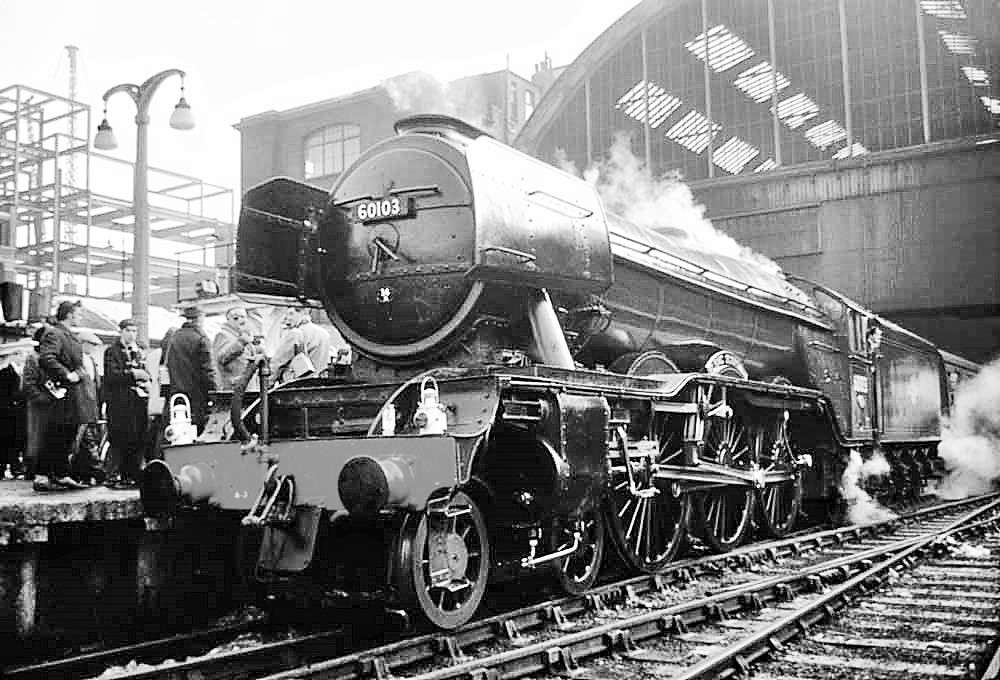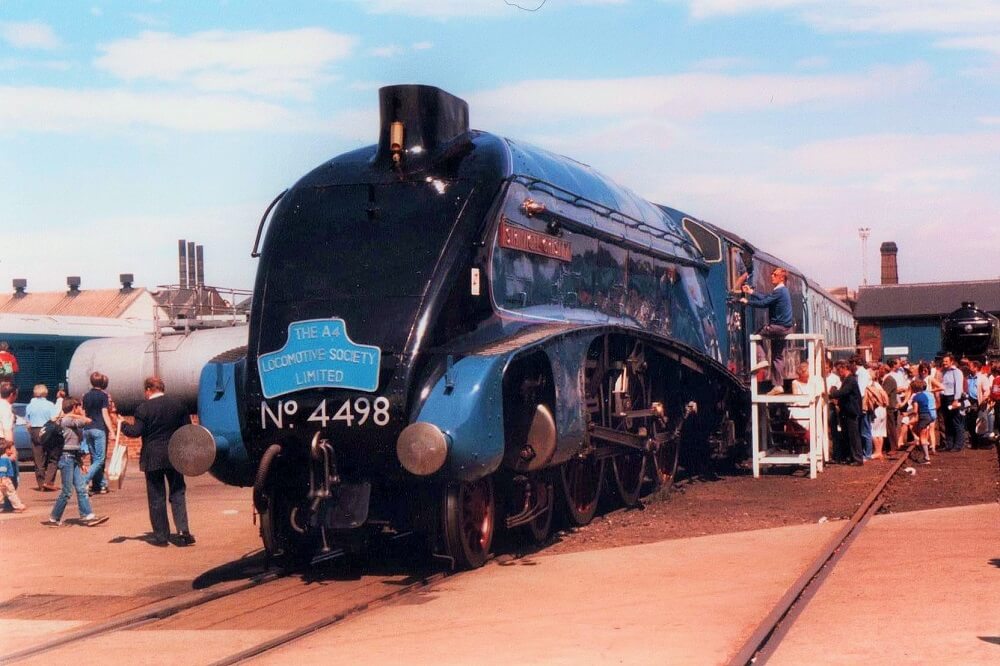Sir Herbert Nigel Gresley (1876-1941)

On the morning of 3 July 1938, most of the Mallard 4468 crew had no idea they were about to make history.
According to the National Railway Museum, which now houses the locomotive, it was not until the train was about to leave Wood Green in north London that the technical team was told what driver Joe Duddington and fireman Thomas Bray already knew – that the purpose of the journey was to set the British speed record for steam locomotives. It was to put Grantham on the railway history map forever, by stopping there, turning round and hit the headlines between Stoke Tunnel and Castle Bytham.
He is remembered in Grantham by Gresley Court’.
Not even Duddington and Bray knew that a world record would still be standing 84 years later, and was likely to stand forever.
The attempt had been authorised by Sir Herbert Nigel Gresley, designer of the Mallard and other pioneering locomotives. Born in Edinburgh in 1876 and educated at Marlborough College, Gresley’s career in rail started with an apprenticeship at the Crewe works of the London and North Western Railway.
He joined the Lancashire and Yorkshire Railway in 1898 and was put in charge of the test room following an apprenticeship. After becoming manager of the Newton Heath Carriage Works in 1902, he moved to the Great Northern Railway, where he became locomotive engineer at Doncaster in 1911, a role that was renamed chief mechanical engineer. With the grouping of rail companies in 1923, Gresley became chief mechanical engineer of the newly formed London and North Eastern Railway (LNER).
The journey to the world speed record started in 1912, when Gresley’s first original locomotive design – a two-cylinder 2-6-0 engine – was built. Ten years later he completed the first of the famous three-cylinder 4-6-2 Pacific engines, many of which were built by the LNER in Darlington and Doncaster. These were regularly improved with modifications such as increased boiler pressures.
In 1925 he introduced the Mikado, a 2-8-2 locomotive for heavy freight traffic. That design was adapted nine years later for the Cock o’ the North, a larger wheeled engine for heavy express work.
In 1935, the Silver Link locomotive was built and entered service on the first completely streamlined train in the UK, making the 232-mile journey from London to Darlington in three hours and 18 minutes.
Three years later, the Silver Link was followed by the Mallard, another A4 class. “Its innovative streamlined wedge-shaped design bore no resemblance to the preceding A3 class (of which Flying Scotsman was an example) and was very much a product of 1930s Britain,” according to the National Railway Museum. “At this time speed was seen as the ultimate symbol of modernity.”
The streamlined 4-6-2 engine clinched the world record as it raced down Stoke Bank, south of Grantham. The crew maintained a speed of 120mph for five miles, with a short burst to 126mph that secured the locomotive’s place in the history books.
The establishment of a locomotive testing station in Rugby was another major achievement for Gresley. “He had long believed this to be of great importance to locomotive engineering in the country,” according to the IMechE archive. Work commenced in 1937, but was postponed by the outbreak of war – unfortunately, Gresley did not live to see its completion.
His efforts during the First World War, to reorganise the Doncaster works for the production of munitions, were rewarded with a CBE in 1920. He received a knighthood in 1937 and also served on several government committees, including on automatic train control and the electrification of railways. He was made president of the IMechE in 1935, and was twice president of the Institution of Locomotive Engineers.
Ask the public to name a famous steam engine and three names usually crop up, the first being George Stephenson’s Rocket, most successful of the early railway pioneers.
Of the many thousands of locomotives to follow, the other two, deep in public awareness, are Flying Scotsman and the world’s fastest steam locomotive Mallard. Both locomotives were built in Doncaster by Sir Nigel Gresley, one of the most celebrated of all railway engineers, They were also regulars at Grantham.
Herbert Nigel Gresley was born in 1876, fourth son of Reverend Nigel and Joanna Gresley. The family could trace their history back to Robert de Toesni, who accompanied William the Conqueror in the Norman Conquest and took their name from Church Gresley in South Derbyshire.
By the time young Nigel arrived, his father was the last of four Gresley rectors of St Peter’s Church in nearby Netherseal although the infant was actually born in Edinburgh where his mother was consulting a gynecologist. Nigel’s early life was spent at the rectory in Netherseal before he was sent to school in St. Leonard’s, Sussex, and completed his education at Marlborough College in Wiltshire.

Here Gresley developed a flair for engineering and one of his mechanical drawings, completed when he was only fourteen, hangs in the Institution of Mechanical Engineers in London today. On leaving school, in 1893, he chose not to follow his father into the clergy, but joined the London and North Western Railway Company as an apprentice, under the watchful eye of F. W. Webb at Crewe.
It is believed that Gresley’s interest in railways came from watching the engines working on the Netherseal colliery branch line as a child. The Crewe works was one of the largest factories in the country, but their engine designs were not always very good. Gresley would learn what worked and, crucially, what did not. He later moved to the drawing office of the Lancashire and Yorkshire Railway Company Works at Horwich, where Sir John Aspinall was creating some advanced designs. Gresley was progressing rapidly up the ladder as he displayed a gift of leadership and engineering skill.
During a spell as locomotive foreman at Blackpool in 1899, Gresley met Ethel Frances Fullagar who would become his wife in 1901. The Gresleys set up home at Newton Heath, outside Manchester, where the first two of their four children were born. In 1905 Gresley was offered the senior post of Carriage and Wagon Superintendent with the Great Northern Railway at Doncaster. This was an outstanding achievement for a man of just 29 and, upon the retirement of Chief Mechanical Engineer Henry Ivatt, in 1911, a further promotion followed. However, his career nearly came to an end on a visit to his mother a year earlier.
Gresley’s first task in charge of the GNR was to ease their shortage of freight engines, as that was where the vast majority of the business lay. His first design was the K1, a 2-6-0 configuration with 5’-7” driving wheels (a size in between small freight and large express wheels). The design proved very successful at pulling both freight and passenger stock. This was followed by a 2-8-0 heavy freight engine and the K2, a revised 2-6-0 with a larger, more powerful, boiler. So far his designs had been fairly conventional, but now Gresley was keen to move forward with new ideas, new designs. With the advent of war he would have to put his plans on hold as Doncaster works was turned over to the manufacture of armaments. Gresley would receive a CBE for his role in supervising the plant through this period.
The war period also gave Gresley time to evaluate his designs, and to consider the success of other designs, all without the pressure to build. There was a general move towards the use of four cylinder engines, with the two additional cylinders between the wheels allowing the use of larger, more powerful, boilers. This would give greater performance, but cylinders balanced on either side of the engine can create a shuffling motion causing stress to both engine and track. Gresley’s early experiment with this layout was unsuccessful and his solution, for the use of a larger boiler, was to feed steam to three larger cylinders, two outboard with one between the wheels. His first three cylinder design was a 2-8-0 which was well balanced and smooth running, just what Gresley needed as he looked to his designs for faster and more powerful express locomotives. Gresley would never again use four cylinders. He also moved the valve gear (considered unsightly by his Victorian predecessors) to the outside of the engine for ease of access with reduced maintenance costs.
For his premier express locomotive Gresley decided against developing Ivatt’s 4-4-2 (Atlantic) design in favour of a Pacific 4-6-2 configuration which would allow a much great boiler capacity. Gresley’s first Pacific class engine No 1470 Great Northern appeared in April 1922 creating a huge amount of publicity on account of the engine’s huge size, yet graceful looks. Nigel Gresley had come to the public’s attention for the first time.

On 1st January 1923 Nigel Gresley became CME of the new London & North Eastern Railway, one of the Big Four railway companies, formed by Act of Parliament, grouping together the hundred-plus companies operating at the time into four large regional operators. The aim of the Act was to make the railways more efficient and cost-effective, as had been the case under state control during the war, but fell short of nationalisation.
he following month Doncaster works turned out one of the most famous engines of all time, class A1 (later changed to A3) Pacific No 1472 Flying Scotsman, named after the train service begun in 1862, by the GNR, and now inherited by the LNER. As head of the new company, Nigel Gresley moved his office to Kings Cross station in London and, as he loved the country, bought a house at Hadley Wood with two tennis courts. The property was quite near to the Golf Club where he soon became Captain. He was also very fond of dogs from his boyhood days, keeping them as companions throughout his life, with a special affection for spaniels.
In 1929 Ethel Gresley underwent a serious operation at the family home. Afterwards the surgeon, Sir Maurice Cassidy, told her husband that the cancer was terminal but Mrs. Gresley, herself, was never told. For months Nigel Gresley had to endure this great ordeal before Ethel died in August. She was buried in Netherseal, her husband’s boyhood home. The strain of that summer aged Gresley considerably, so he accompanied by his eldest daughter to Canada, where he hoped the bracing Rocky Mountains air would give him the tonic he needed. During their stay in Banff Gresley was able to spend a day on the footplate driving one of the giant Canadian Pacific steam locomotives to Glacier in British Columbia.
The following year Gresley moved to Salisbury Hall near St. Albans, an Elizabethan residence surrounded by a moat. Here he would enjoy one of his great passions, that of keeping and breeding many species of wild duck, including his favourite… the mallard.
As an engineer he was greatly interested in railway developments abroad and keen to converse and exchange ideas with others. He was great friends with André Chapelon, CME of the Paris-Orleans Railway. Like Gresley, Chapelon was actively involved in experimental designs and had successfully redesigned boilers to burn hotter and more efficiently, breathing new life into aging French stock. Chapelon also helped design the Kylchap exhaust system which drew the hot gasses faster through the boiler, heating the water more quickly. This would become an important aspect of Gresley’s later designs. Gresley was also introduced to French based racing car designer Ettore Bugatti. They would often discuss their ideas for streamlining, at that time still quite a futuristic concept. The 1930’s was a period when the Big Four found that there was great prestige in providing faster services and speed records generated huge amounts of publicity. In particular there became a race to provide the fastest service from London to Scotland between the LNER, Kings Cross to Edinburgh, and the Euston to Glasgow service of the London, Midland and Scottish (LMS) railway.
In 1934 the (now re-numbered 4472) Flying Scotsman became the first steam locomotive to officially reach 100mph. Gresley was already working on his next masterpiece, the streamlined A4 class Pacific. The first batch of four A4s was introduced in September 1935 in a striking silver and grey livery to pull the Silver Jubilee train, marking the jubilee of King George V and Queen Mary. No 2509 Silver Link set a new British speed record, twice touching 112mph, on the return trip from Grantham to Kings Cross during the inaugural run.
The following year Sir Nigel Gresley received his knighthood from King Edward VIII in recognition of his services as chairman of the committee looking into the loss of steam ships Usworth and Blairgowrie. Both had been lost at sea in quick succession, apparently due to steering failures in the winter of 1934-5 with the loss of 43 lives. In 1936 Sir Nigel also received an honorary Doctor of Science from the University of Manchester and was elected President of the Institution of Mechanical Engineers.
In August 1936 another of the original A4s, 2512 Silver Fox, reached 113mph on a regular southbound express, a record that would stand until the 1970s as the fastest revenue earning train, but the British speed record was taken by the LMS in July 1937 when their new Coronation streamliner recorded 114mph just outside Crewe.
The next batch of A4s to appear, in early 1938, were named after birds, with No 4468 Mallard receiving special attention from its designer, having all the latest modifications: streamlined air passages, more powerful boiler, new Westinghouse brake system and a double chimney with a Kylchap blastpipe. Mallard set the world steam record on 3rd July 1938 between Grantham and Peterborough, a record that still stands today. The following year the directors of the LNER named their 100th Pacific locomotive, built to Sir Nigel’s designs, A4 No. 4498 Sir Nigel Gresley.

Sir Nigel enjoyed smoking a pipe which he found brought contentment and peace of mind. It was only when he laughed out loud, in his employees’ presence, that his light -hearted character was revealed to them. At parties with friends he would see to it that everyone enjoyed themselves, even going to the extent of playing good humoured jokes on the guests. Neither was he afraid to have the laugh on himself, in return. His railway work called for him to be serious, too. He was well aware of the capabilities and limitations of the staff, always being willing to explain to them points that were not clear. On occasion Sir Nigel would even sketch a drawing on his note pad, to explain a particularly difficult job.
Since 1927 Sir Nigel had cherished hopes of a national locomotive testing plant, for the ‘attainment of increased efficiency’ but times were hard and government help was not forthcoming. He persevered however, enlisting the support of LMS CME Sir William Stanier. Eventually the directors of the LMS and LNER agreed to pool their resources and gave the go-ahead, in 1937, for a plant to be built at Rugby but the outbreak of war, in 1939, brought this to a halt.
Heart specialist Sir Maurice Cassidy had previously warned Sir Nigel that his work rate was detrimental to his health. Early in 1941 Sir Maurice again warned him that he would not live for six months unless he cut down his work to only four days a week but Sir Nigel said it was not possible, he could not be seen to slacken his work during a war when everyone else was working to their best ability.
Sir Nigel died on 5th April, 1941 after a short illness, and was laid to rest beside his wife in Netherseal. His long cherished dream came true on 19th October, 1948 when the national test plant was officially opened, with two of his family in attendance. Fittingly, the first locomotive to be run on to the test rollers was A4 Pacific Sir Nigel Gresley.
To mark the 75th anniversary of his death, a statue of Sir Nigel Gresley, by sculptor Hazel Reeves, was unveiled at King’s Cross station in London on 5th April 2016. The plan to include a duck at Gresley’s feet, a tribute to his love of water fowl, and to the engine Mallard, was abandoned when two of Gresley’s grandsons complained that it was ‘demeaning‘. The statue depicts Sir Nigel looking out across King’s Cross station, London terminus of the LNER and clutching a copy of The Locomotive magazine bearing a front-page story about Mallard.
As British Railways moved towards dieselisation, Flying Scotsman was saved from the scrapyard in 1963 by Alan Pegler. In preservation Flying Scotsman has always been a major attraction and is now owned by the National Railway Museum. Following a decade-long £4.2 million restoration, completed at steam and diesel engineering specialists Riley and Son Ltd in Bury, Flying Scotsman returned to the mainline, carrying its British Railways number 60103, hauling steam specials in 2016 drawing huge crowds and selling out rail tours across the country, still the most cherished steam locomotive in Britain and a living memorial to the outstanding talents of Sir Nigel Gresley.




Leave a Reply
You must be logged in to post a comment.